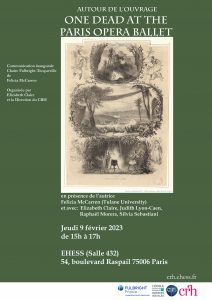Autour de l’ouvrage de Felicia McCarren, One Dead at the Paris Opera Ballet
 Jeudi 9 février 2023 de 15h à 17h
Jeudi 9 février 2023 de 15h à 17h
Table ronde
Présentation
In 1866, when the ballet La Source debuted, the public at the Paris Opera may have been content to dream about its setting in the verdant Caucasus, its exotic Circassians, veiled Georgians, and powerful Khan. Yet the ballet’s botany also played to a public thinking about ethnic and exotic others at the same time-and in the same ways-as they were thinking about plants. Along with these stereotypes, with a flower promising hybridity in a green ecology, and the death of the embodied Source recuperated as a force for regeneration, the ballet can be read as a fable of science and the performance as its demonstration. Programmed for the opening gala of the new Opera, the Palais Garnier, in 1875 the ballet reflected not so much a timeless Orient as timely colonial policy and engineering in North Africa, the management of water and women.
One Dead at the Paris Opera Ballet takes readers to four historic performances, over 150 years, showing how– through the sacrifice of a feminized Nature– La Source represented the biopolitics of sex and race, and the cosmopolitics of human and natural resources. Its 2011 reinvention at the Paris Opera, following the adoption of new legislation banning the veil in public spaces, might have staged gender and climate justice in sync with the Arab Spring, but opted instead for luxury and dream. Its 2014 reprise might have focused on decolonizing the stage or raising eco-consciousness, but exemplified the greater urgency attached to Islamist threat rather than imminent climate catastrophe, missing the ballet’s historic potential to make its audience think.
Version française :
Lors de son début à l’Opéra de Paris en 1866, le ballet La source aurait enchanté un public cherchant un paradis sur terre : la mise en scène propose un Caucase verdoyant, peuplée de Circassiens, de Georgiennes voilées, et d’un puissant Khan. Or, la thématique botanique dans le ballet parlait à un public déjà familier avec les écrits de voyageurs naturalistes représentant des rencontres avec des étrangers exotisés selon des notions de classification botanique des plantes. A côté donc des stéréotypes théâtraux, tels une fleur promettant l’hybridité dans une écologie verte, ou encore le sacrifice tragique de La Source incarnée par une ballerine, on pourrait lire dans ce ballet une fable sur la science dont le spectacle fut sa démonstration. Programmé pour l’inauguration du Palais Garnier en janvier 1875, le ballet a moins reflété un Orient atemporel et idéalisé que l’actualité d’un Maghreb colonisé, la politique coloniale en Afrique du Nord, et sa gestion de l’eau et du subalterne.
One Dead at the Paris Opera Ballet emmène son lecteur à travers quatre représentations historiques du ballet La Source afin de montrer comment, pendant un siècle et demi, et dans le sacrifice d’une Nature féminisée, ce ballet a mis en scène une politique sexuelle et raciale, et une cosmopolitique des ressources humaines et naturelles. Sa réinvention en 2011, suite à l’adoption de la loi sur la dissimulation du visage dans l’espace de la République française, aurait pu afficher une politique écoféministe inspirée par le printemps arabe, or la production a opté pour une rhétorique du luxe et un ré-enchantement du public. La reprise du ballet en 2014 aurait pu rejoindre les efforts de décoloniser la scène, il aurait pu proposer une réflexion écologique, mais elle a préféré signaler un état d’urgence rattachée à la violence islamiste tout en ignorant la crise climatique qui s’est retrouvé reléguée, par conséquent, à l’arrière-plan de la scène politique. En ceci, la production a désavoué le potentiel historique de ce ballet, privant ainsi son public d’une matière importante à la réflexion collective.
Autour de l’autrice Felicia McCarren (Tulane University), interviendront Elizabeth Claire (Histoire du Genre-GEHM), Judith Lyon-Caen (GRIHL–HHS), Raphaël Morera (GRHEN) et Silvia Sebastiani (GEHM).
Lieu
EHESS (Salle de co-working, A4_32, 4e étage)
54, bouelvard Raspail
75006 Paris


